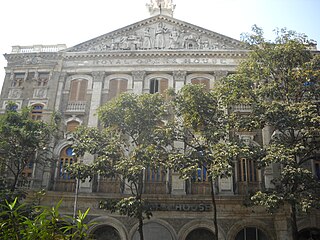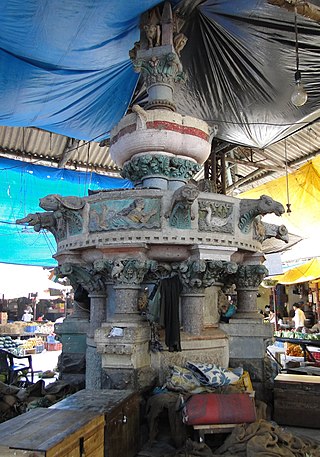Early life


Lambah was born in Calcutta (now Kolkata) and grew up in Ballygunge. She attended the Loreto House school and then graduated from the School of Planning and Architecture, New Delhi. [6] [2]
Abha Narain Lambah | |
|---|---|
| Born | 1970 Calcutta, India |
| Nationality | Indian |
| Occupation | Architect |
| Awards |
|
| Projects | Ajanta Caves, David Sassoon Library's 2023 Restoration |
| Website | www |
Abha Narain Lambah (born 1970) is an Indian conservation architect whose eponymous architectural practice has restored several of India's UNESCO World Heritage Sites like the Ajanta Caves, Golconda Fort and Mahabodhi Temple, and Mumbai's Victorian buildings like the Crawford Market, Royal Opera House, Asiatic Society of Mumbai Town Hall and Knesset Eliyahoo Synagogue. [2] [3] [4]
The firm's work has been recognised by 13 UNESCO Asia-Pacific Awards for Cultural Heritage Conservation. In 2007 her work of the Conservation of the Chamba Lakhang Buddha Temple in Basgo Ladakh won the Award of Excellence and the Convocation Hall Mumbai University the Award of Distinction UNESCO Asia Pacific Awards. In 2017, their restoration work on the Royal Opera House, India's only surviving opera house, was given the Award of Merit under the UNESCO Asia-Pacific Awards for Cultural Heritage Conservation. [5]
Their ongoing projects include the restoration of the Mughal Garden of Shalimar Bagh Kashmir, Preparation of UNESCO Nomination for the Mughal Gardens of Kashmir; Sarnath and Monuments of Mandu. The firm prepared the successful UNESCO Nomination Dossiers for the World Heritage Sites of Rabindranath's Santiniketan and Mumbai's Victorian and Art Deco Ensembles as well as Management Plans for Amber Fort and for Le Corbusier's historic Chandigarh Capitol Complex in Chandigarh. [6]
The architectural practice has worked on a range of historic forts and caravanserais across Rajasthan, Maharashtra and Punjab as well as Buddhist sites such as Bodh Gaya, Sarnath, Ajanta and Basgo.
Abha has been on the Expert Committee for the Rashtrapati Bhavan Museum and Mentor Indian Museum Kolkata. The practice has over the last 25 years, focused on museum projects across the country that include Chhatrapati Shivaji Maharaj Vastu Sangrahalaya Mumbai, Chowmahalla Palace Museum Hyderabad, Jaivilas Palace Museum Gwalior, Lalbagh Palace Museum Indore, Bharatpur Museum, Jaipur Metro Museum, Anand Bhavan Allahabad, Nehru Memorial Library & Museum Delhi, Mani Bhavan Gandhi Sangrahalaya Mumbai and Russia's oldest museum, the Kunstkamera. She is currently working on the Museums of Freedom & Kashmir at Delhi's Red Fort Delhi, Balasaheb Thackeray Rashtriya Smarak and Urban Conservation at Vadnagar. She served on the Governing Council INTACH and was Jury Chair – ADC Awards New York and has been a juror on the Golden Trezzini Awards.


Lambah was born in Calcutta (now Kolkata) and grew up in Ballygunge. She attended the Loreto House school and then graduated from the School of Planning and Architecture, New Delhi. [6] [2]
Lambah set up her architectural practice in 1996. Her first project was to finalise urban signage and street furniture guidelines for Dadabhai Naoroji Road, along which many of the city's Gothic Revival and Neoclassical buildings are located. In 2000, she became a conservation consultant to Rahul Mehrotra Associates, who were restoring the Chowmahalla Palace in Hyderabad. Between 2004 and 2006, she worked on the 15th-century Basgo Monastery and restored the Maitreya Buddha. [7] Since 2010, she has restored many of Mumbai's Victorian, Neo-Gothic and Indo-Saracenic buildings, such as the Municipal Corporation Building, Crawford Market, Prince of Wales Museum, Convocation Hall, University of Mumbai, Knesset Eliyahoo Synagogue, Mumbai. [8] [9] [10] Lambah has acknowledged the influence of Joseph Allen Stein and Charles Correa on her practice. [11]

Kala Ghoda is a crescent-shaped art district/neighborhood in Mumbai, India. It hosts several of the city's heritage buildings including museums, art galleries and educational institutions like the Chhatrapati Shivaji Maharaj Vastu Sangrahalaya, the Jehangir Art Gallery, the National Gallery of Modern Art, and The Arts Trust - Institute of Contemporary Indian Art.

The David Sassoon Library and Reading Room is a famous library and heritage structure in Mumbai, India. The idea for a library to be situated in the center of the city came from Albert Sassoon, son of the famous Baghdadi Jewish philanthropist, David Sassoon.

The Municipal Corporation Building, Mumbai, located in South Mumbai, Maharashtra, India is a Grade IIA heritage building opposite to the Chhatrapati Shivaji Terminus at the junction of Dadabhai Naoroji Road and Mahapalika Marg. It is also known as the BrihanMumbai Municipal Corporation Building, or BMC building for short.

Chowmahalla Palace or Chowmahallat is the palace of the Nizams of Hyderabad State located in Hyderabad, Telangana, India. It was the seat of power of the Asaf Jahi dynasty (1720-1948) and was the official residence of the Nizams during their reign. Presently the palace is converted into a museum but the ownership still lies with the family.

The Knesset Eliyahoo, also Knesset Eliyahu, is an Orthodox Jewish synagogue located in downtown Mumbai, India. It is the city's second oldest Sephardic synagogue. It was established in 1884 by Jacob Elias Sassoon, son of Eliyahoo David Sassoon and grandson of David Sassoon; the latter had immigrated from Baghdad to India in 1832 due to persecution and had settled in Mumbai, then known as Bombay. It is maintained by the Jacob Sassoon Trust. The building's significance is attributed to its Jewish traditions as well as Indian and English colonial influences.

Royal Opera House, more commonly known simply as Opera House in Mumbai, is India's only surviving opera house.

Dadabhai Naoroji Road (D.N.Road), a North–South commercial artery road, in the Fort business district in South Mumbai of Maharashtra, India, is the nerve centre of the city, starting from the Mahatma Phule Market ,linking Chhatrapati Shivaji Maharaj Terminus, leads to the Hutatma Chowk at the southern end of the road. This entire stretch of the road is studded with Neo–Classical and Gothic Revival buildings and parks built in the 19th century, intermingled with modern office buildings and commercial establishments.

Jama Masjid or Jama Mosque or Jami Masjid or Badi Masjid, one of the largest Mosques in India, is a 15th-century mosque built by Hussain Shah Sharqi of the Jaunpur Sultanate in Jaunpur, Uttar Pradesh, India. It is one of the chief tourist attractions in Jaunpur. The mosque is 2.2 km north-northeast of Jaunpur, 7.3 km northwest of Zafarābād, 16.8 km north-northeast of Mariāhū, 26.3 km west-northwest of Kirākat. It is 1 km from the Atala mosque.
The architecture of Mumbai blends Gothic, Victorian, Art Deco, Indo-Saracenic & Contemporary architectural styles. Many buildings, structures and historical monuments remain from the colonial era. Mumbai, after Miami, has the second largest number of Art Deco buildings in the world.

Ballar Bunder Gatehouse is a Grade I Heritage structure that has been converted into a maritime museum, located at Ballard Estate in the old Fort area of Mumbai, India. It was built in 1920 to commemorate the realignment of the harbour and is located where Ballard Pier, a small pier once existed with an approach jetty at right angles to the pier. The building was among the five entries from the Mumbai for the 2009 UNESCO Asia-Pacific Heritage Awards for Culture Heritage Conservation. It is one of the stops on Special tour of Museums in the city, a tour organised by BEST and MTDC as well as the Naval Dockyard Heritage Walk, conducted by the Naval Dockyard on the first Sunday of every month.
Rahul Mehrotra is Founder Principal of architecture firm RMA Architects of Mumbai + Boston, and is Professor of Urban Design and Planning and Chair of the Department of Urban Planning and Design at the Harvard Graduate School of Design (GSD) in Cambridge, Massachusetts.

Loreto House was established in 1842 in Kolkata, by the Sisters of Loreto belonging to the institute of the Blessed Virgin Mary. It is the oldest and the first Loreto institution to be established in India and was one of the few all-girls Catholic schools of that time.
UNESCO Asia Pacific Heritage Awards are given with as the strategic purpose of UNESCO with in the region Asia Pacific. The objective is to motivate the protection of Cultural Heritage sites, which are initiated by any individual organization under private sector or institutional organization.

Many heritage structures are found in Mumbai, India.

The Victorian Gothic and Art Deco Ensembles of Bombay is a collection of 19th-century Victorian Revival public and 20th-century Mumbai Art Deco private buildings in the Fort precinct of Mumbai. This ensemble was declared a UNESCO World Heritage Site in 2018.

Aishwarya Tipnis is an Indian architect, educator and heritage conservationist, whose eponymous practice Aishwarya Tipnis Architects focuses on heritage conservation of neglected monuments and significant buildings of India. In 2015, her work on the century-old Main Building of The Doon School received the Honourable Mention under the UNESCO Asia-Pacific Awards for Cultural Heritage Conservation. In 2016, the firm's restoration work on the walls and bastions of the 18th-century Mahidpur Fort, in Madhya Pradesh, was given the Award of Merit under the UNESCO Asia Pacific Heritage Awards. In 2018, she became the youngest architect to be appointed the Chevalier de l'Ordre des Arts et des Lettres by the French government for her preservation work of French heritage in India, particularly Chandernagore in West Bengal. Tipnis was part of the UNESCO Expert Team for preparing the Comprehensive Conservation Plan for the Darjeeling Himalayan Railway, a UNESCO World Heritage Site. She has been recognised as a Global Cultural Leader by the European Union in 2016.

Crawford Market Fountain or Lockwood Kipling Fountain is a listed heritage structure in Crawford Market, Mumbai that was erected in 1874, and was designed by William Emerson, the British architect who also designed the market. The style is a mix of Greek Revival and Neo-Gothic, and the four carvings depicting the Indian river goddesses and native birds were done by John Lockwood Kipling, who was the principal at Sir Jamsetjee Jeejebhoy School of Art.
Vikas Dilawari is an Indian conservation architect who has restored at-risk monuments and heritage buildings in Mumbai, including the Victoria Terminus, Rajabai Clock Tower, Dr. Bhau Daji Lad Museum, Wellington Fountain and Christ Church, Byculla. 16 restoration projects carried out by his team have been recognised by the UNESCO Asia-Pacific Awards for Cultural Heritage Conservation, including the 2019 work on the Flora Fountain, which was designed by architect Richard Norman Shaw and completed in 1864.

The Convocation Hall or Cowasji Jehangir Convocation Hall at the University of Mumbai is part of the Victorian buildings complex around the Oval Maidan in Mumbai that is a UNESCO World Heritage Site. It was built between 1869 and 1874, and designed by Sir George Gilbert Scott, who incidentally never visited Bombay and worked from London.